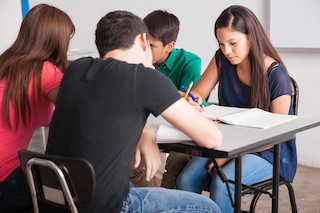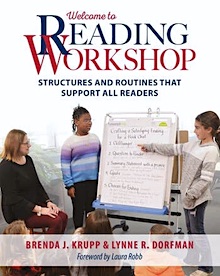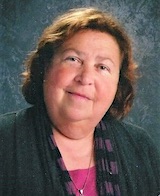Small Group Strategies That Build Literacy Skills
By Lynne Dorfman and Brenda Krupp
Small group instruction can and should be a part of the work we do in reading and writing classrooms.
Using this strategy to reduce teacher-student ratio, educators can not only personalize learning but can also provide the time to review, reteach, and apply a strategy learned in a minilesson.
It’s important to understand that small group instruction does not have to be about teaching something new. Sometimes we need to examine a strategy through a new lens. Other times, we can introduce new vocabulary, frontload background knowledge our students do not have, reinforce phonics skills such as using multisyllabic syllable patterns to decode and pronounce words, or introduce a new text structure such as cause and effect or problem/solution.
Whether they are a quick check in or a chance for slow and deliberate study, small groups provide opportunities for students’ voices to be raised as they discuss, suggest, question, and evaluate.
According to the metadata analyzed by researcher John Hattie (2009, 2018), small group instruction significantly impacts student achievement. It’s a safe environment that helps students share their thinking and build confidence and self-esteem.
Small groups also provide time for peer interaction, close observation by the teacher, and opportunities to explicitly teach or reteach a strategy and check for understanding. An overall goal for small group instruction is to move on to increasingly difficult texts by reading strategically and fluently.
Flexible Grouping
The essential key to small group instruction is the flexible framework that you will create. By grouping students together based on their individual strengths, interests, and areas for growth, you can create a more supportive and engaging learning environment and give students exactly what they need at any given point in time.
Flexible grouping can help you differentiate reading instruction and allow students to see the relevance of what they’re learning and connect it to their own interests, which can make learning more meaningful and engaging.
Certainly, educators can meet the social-emotional needs of their students by giving them a chance to work with peers of different abilities and backgrounds. Students can build relationships and develop empathy and understanding for others, promoting a positive classroom culture and improving overall student well-being.
Groups should be fluid and dynamic to meet the needs of the students in your classroom. When small groups are not fixed for the entire year, students don’t feel stuck. They are more engaged and motivated to participate. Flexible grouping requires careful planning and rethinking how the groups are working. It’s helpful to set aside dedicated planning time to create and revise groupings based on ongoing assessments and student needs.
Creating Groups
What have you observed that would indicate the need for a small group to be convened? Using data you have collected from observing students, anecdotal records, conference notes, and other informal (as well as formal) assessments can help you create a small group around an instructional need. An exit slip strategy may help you group students who may need immediate remediation or may point to a group that would benefit from enrichment.
Note who is in a group and the goal for the group in order to shuffle students in and out of groups as students progress. Weekly lists help you keep track of students you are seeing and who you will want to include in the weeks ahead.
Timing
You have a lot of choice in deciding when to hold your small group meeting. Knowing the purpose for calling a group together will help determine when you meet.

Groups can meet throughout your independent reading time, but remember to save time in your workshop to confer 1-1 with readers and to allow students time to read independently. It can be easy to get caught up in teaching a group, and before you know it, your conferring time (and their reading time) have disappeared.
Remember, small groups do not have to meet every day of the week. Create a schedule so you can meet with two groups twice a week on different days. Perhaps a more sophisticated group that is trying out something totally new for the grade level can meet once a week (maybe on a Friday). The goal is to ensure that all small group members get extended time to read during independent reading time.
Taking Notes
Finding a note-taking system that works for you is key! Will you use a sticky note to jot one of two observations on each child in the group? Placing the sticky notes on a clipboard and then transferring them to a more permanent notebook with a page for each student in your class will ensure they are available later and can be used for assessment purposes.
Some General Tips to Consider
- Organize your ideas and information from what you see and hear.
- Keep focused and stay engaged on the task at hand.
- Listen more; talk less.
- Keep a record of what you have observed, transferring notes from index cards or sticky notes to a larger notebook or binder or onto a computer file so you can more easily locate it in the future.
- Write down what students can do so instructional decisions are based on children’s strengths (Starting with Jane cannot…or Jane doesn’t…works off of a deficit model instead of abundance. (See Edutopia, “Tools for Teaching: Ditching The Deficit Model” by Rebecca Alber.)
- Take a photo of student work or behavior to add to an anecdotal record.
- Think critically about what you are observing while you are observing it.
- Draw conclusions and identify areas of need (concern).
- Abbreviations can capture detailed observations in an efficient way.
- Be prepared to reread your notes and use them to form new groups, adjust the groups you presently have, and refocus instruction by addressing any areas of concern.
We recommend using a three-column format to organize your notes – one for the notes, another for your reflections and thoughts about the observation, and the last column for ideas about future instruction. Remember, if you are not comfortable with your system, you will probably not use it, so take time to rethink what you are comfortable using and what helps you gather and keep information for future reference.
Recognize that your notes are for your reflection. Consider revising your notes for clarity if you are going to share with colleagues, caregivers, or administrators.
Final Thoughts
Small group instruction enhances your reading community by increasing peer interaction time and building students’ confidence. It allows for increased instructional time, focuses on specific goals, and improves the use of skills and strategies taught in the minilesson.
The universal skill we want to highlight here is transfer. Small group instruction helps students imagine how they will infuse their new learning into their future reading work. The interpersonal skills they build in small group instruction will help them read with enthusiasm and confidence, increasing their desire to read independently.

Dr. Lynne R. Dorfman is on the leadership team for the West Chester Writing Project. Lynne has been an adjunct professor for Arcadia University for the past 24 years and loves interacting with graduate students. She enjoys her work as a co-editor of PA Reads: Journal of Keystone State Literacy Association and is past president of Eta, a chapter of Alpha Delta Kappa. Lynne is a co-author of many books including Grammar Matters: Lessons, Tips, and Conversations; Using Mentor Texts, K-6; A Closer Look: Learning More About Our Students with Formative Assessment, K-6; and Welcome to Writing Workshop with Stacey Shubitz.
Brenda Krupp served as a third-grade teacher at Franconia Elementary School for over 25 years and holds a Master’s degree in Curriculum & Instruction from Penn State University. She also served as teacher-on-assignment, coaching teachers in reading and writing practices. Brenda has been Co-Director for the PA Writing & Literature Project and co-facilitated the summer invitational Writing Institute, a six-credit graduate level course. She has presented at NCTE, PAWLPdays, and other local conferences. Brenda has also facilitated various courses in the teaching of writing and consulted with school districts on teaching writing (K-5).

































